DAMASCUS and MAALOULA, SYRIA — (Report) In April 2018 I returned to Syria, visiting recently-liberated areas in eastern Ghouta and also travelling to the southern village of Hadar — which at the time was under continual bombardment by terrorists just to the south, with the assistance of Israel and its observation towers over the region.
My focus last April and May was highlighting this media-neglected issue, but also going to the site of the concocted and yet-unproven allegations of a chemical weapons attack. Indeed, as I wrote, no one at the hospital in question, nor the people of Douma I spoke with on the street, believed a chemical attack had occurred. Instead, they were more concerned with detailing the horrors and starvation they had lived under the rule of Jaysh al-Islam and other terrorist factions.
So, the focus of my last visit to Syria, which has been warred upon for the last seven years, was in highlighting the crimes of the terrorist factions against civilians, but also the crimes of the Western and regional nations promoting war propaganda and baseless accusations against Syria and its allies.
In early September, I returned to Syria for more uplifting reasons: to attend two important annual events that in recent years were interrupted due to terrorism: The annual Damascus International Trade Fair and Maaloula’s annual Holy Cross Festival.
A Crowded, Peaceful Damascus International Trade Fair and Revival
This year, both went on in a cheerful climate, and the only blasts were celebratory ones. The resumption and successful holding of these events is a clear indication that Syria is returning to peace, and is closer than ever to ending the war that the NATO-Gulf-Israeli alliance plotted years before 2011.
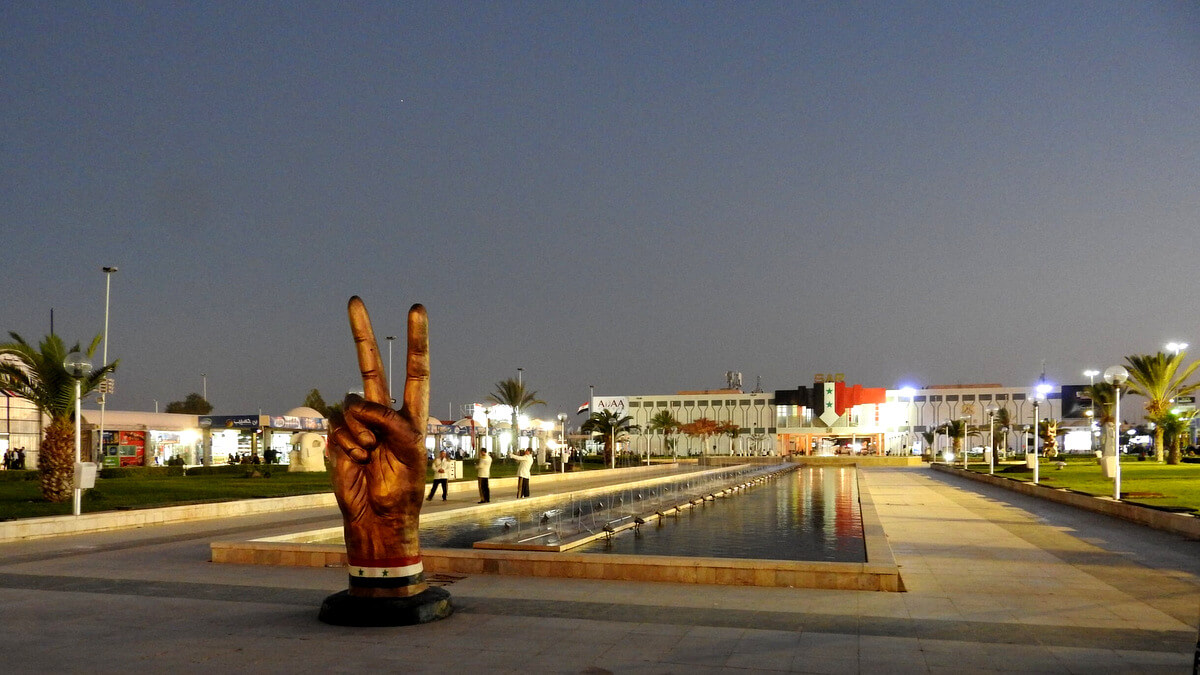
At the Damascus International Trade Fair Ground, Opening Night. Eva Bartlett | In Gaza
In 2017 the trade fair, in its first year resumed since 2012, was attacked by terrorists who were then occupying eastern Ghouta. Six people were killed. On September 6, the opening night of the 2018 fair, I encountered Fares Shehabi, a Syrian MP who elaborated on the murders:
“Those in eastern Ghouta, the so-called ‘rebels’, al-Qaeda gangs, they targeted the entry of this fair and killed some people — visitors and participants. One lady from old Damascus was killed. She was participating in this fair — she had a clothing garment factory — and she was killed at the door.”
Watch | Aleppo MP Fares Shehabi on the re-opening of the Damascus International Fair
This year, with Damascus’ Yarmouk district (formerly occupied by ISIS and al-Qaeda) liberated, and with the liberation of eastern Ghouta — the source of most of the missiles and mortars that killed over 10,000 civilians in Damascus alone — there was no concern that the deadly attack of 2017 would be repeated.
The official opening ceremony included a year-by-year overview of the six decades of fairs past — minus the years 2012-16 — and various stunning musical and dance performances.
I revisited the fairgrounds just south of Damascus after the opening events and while walking around I saw the diversity that is Syrian culture, including young women dressed how they chose — something unthinkable under the rule of the fanatical extremists who occupied the now-liberated areas. In fact, under their rule, women wouldn’t be out strolling period, much less doing so with male friends.
The atmosphere was in that regard less that of a trade fair and more of a public park with people sprawled on lawns, picnicking and children playing. Elsewhere, music blasted from fair booths and from stages set up to entertain the crowds, including a children’s concert where a young boy impressively crooned a song by legendary Syrian singer George Wassouf.
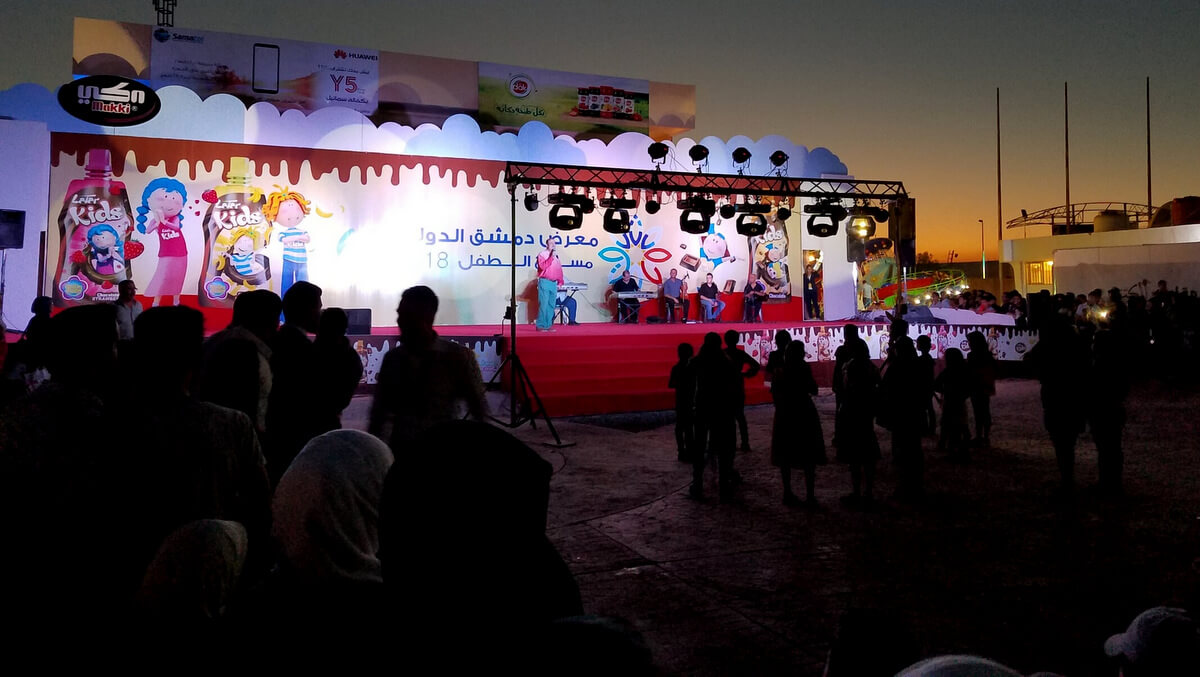
A crowd watches a children’s singing competition at the Damascus International Trade Fair. Eva Bartlett | In Gaza
A novelty at this year’s fair was the Sahab 73 two-seater plane, designed and built by Syrian engineers — the “first nationally-made aircraft,” as SANA reported.
Fares al-Kartally, the fair’s General Director, told me that of the 48 countries participating, 27 of them were officially participating through their embassies and 21 through companies and agents. The latter included companies from France, Britain, Spain, and some Arab countries, including Jordan and the United Arab Emirates.
In fact, 1,722 companies participated in the trade fair, the main participants being Russian, Indian and Iranian. That said, walking around the exhibits, I also saw South Korean, Cuban, and countries neighbouring Syria participating, offering services and goods from textiles, medicines, cosmetics, and food products to products and skills for Syria’s much-needed reconstruction. Of that reconstruction phase, al-Kartally noted it is Syria that will decide who will participate in its reconstruction.
A representative of a Russian company specializing in metal and steel production for warehouses and agricultural use told me:
It’s just this year that you will be able to foresee the next steps for Syria. Last year, it was very hard to tell when this will be over. This year, we thought it was the right time to participate. We believe this is the right time to come and help the government of Syria, through Russian cooperation, to rebuild Syria, the infrastructure and food security.”
Corporate media has spun this as being a bidding ground for exclusively Russian and Iranian companies. But in reality, while Russia and Iran definitely have a strong presence here, many other nations are present.
In any case, Russia and Iran have not imposed criminal sanctions on Syria, nor have they supported terrorists there. To the contrary, they have been a vital part of the defeat of terrorism in Syria, and a return to peace and stability in liberated areas, providing the peace that allowed the fair to take place.
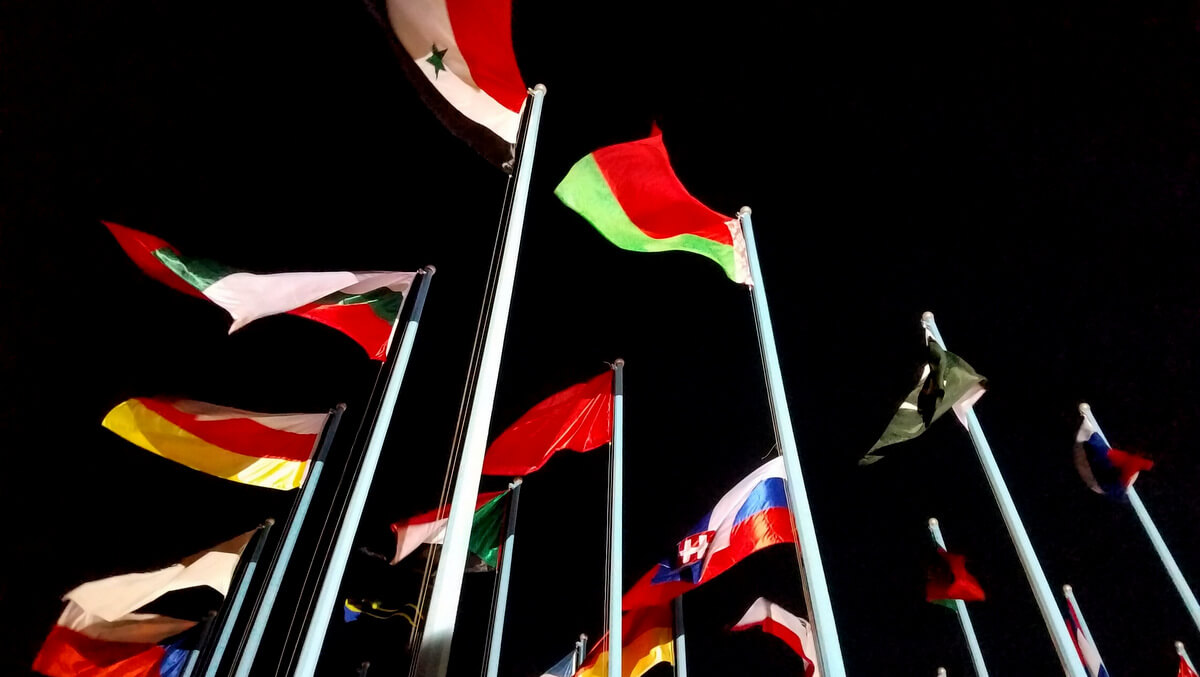
Flags of countries participating in the Damascus International Trade Fair fly outside of the fairgrounds in Damascus, Syria. Eva Bartlett | In Gaza
In our conversation on the opening night, Fares Shehabi said:
We expect high participation from many countries and local firms. It’s about a political statement, an economic statement, that we won this war and we will win also the reconstruction war, and this is just one proof of it.”
Notably absent were companies from Saudi Arabia and Turkey.
As al-Kartally reflected:
In 2007, I took a course in strategic planning in Jeddah, Saudi Arabia. The instructor was American. He was talking about countries witnessing rapid economic growth, so I mentioned Syria. He looked at me and laughed, and said, ‘These countries will create problems for you,’ referring to Saudi Arabia and its allies.”
And indeed, they did.
However — after seven years of war, untold tragic loss of life, and immense destruction in areas occupied or targeted by terrorists — the tide is turning for Syria. Rebuilding will be a challenging process, to put it mildly, but more importantly, in my experience, most Syrians first and foremost want an end to terrorism. That wish has been widely granted — thanks to the Syrian army, government, and Syria’s political and military allies.
Yet Idlib remains occupied by al-Qaeda and other fanatics. And eastern Syria remains occupied by the U.S., its allied forces and other fanatics — including ISIS — who seem to flourish wherever an American presence has a hand.
According to al-Kartally, the 2017 trade fair saw over 2.2 million visitors attend over the course of 10 days:
Last year’s Fair was the first held in many years during the crisis and for people it was a chance to get out and breathe after feeling suffocated for so long.”
On September 7, its first day open to the public, this year’s fair saw 112,000 visitors. On the fifth day, nearly 220,000 visitors attended. By September 14, the eighth day of the fair, a reported half million visitors went to the fairgrounds.
One night at around 8 p.m., I walked out of the fairgrounds to hail down a taxi on the airport road. I walked past a parking lot filled with buses providing free transportation to and from the fair. Adding to the masses already at the fair, people streamed in to spend their night out with family or friends.
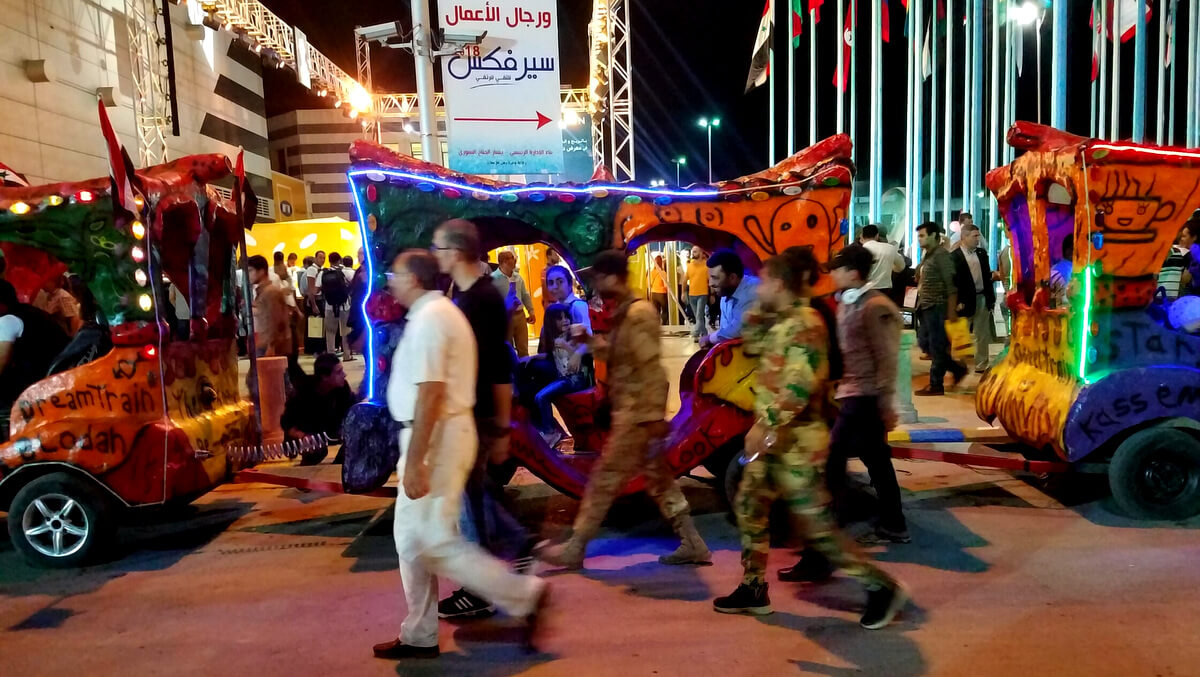
Fair-goers walk through the fairgrounds at the Damascus International Trade Fair in Damascus , Syria. Eva Bartlett | In Gaza
On September 15, the fair’s final day, Israel again illegally targeted Syria, firing missiles — which were intercepted by Syrian air defenses — towards the Damascus International Airport, not far from the fairgrounds.
The response of the fairgoers was to dance defiantly.
As Fares Shehabi wrote, “This is how Syrians attending Damascus International Fair reacted to the Israeli assault on the adjacent airport..! Defiance..! With people like that we cannot be defeated.”
As Syrian comedian Treka reported, the fair captures the sentiments many visitors were feeling: impressed that, so soon after the liberation of eastern Ghouta and Damascus, there had been so much change for the better in and around Damascus; encouraged that the war on Syria is drawing to an end and peace will prevail; and immense admiration for the Syrian people for remaining steadfast for their country, and with their army — which has, with Syria’s allies, nearly eradicated terrorism in Syria.
Damascus 60th International Fair 2018 by Treka Zn
Damascus 60th International Fair 2018 by Treka ZnMore than 48 countries and 1700 companies participated in this fair This will help boost the Syrian economy when the war is over.If these countries and companies din’t see that Syria will soon be completely liberated from all terrorists groups, they wouldn’t have participated in this event and offered their products and services.Share
Posted by Treka Zn on Monday, September 17, 2018
Life, Love, Peace: The Maaloula Festival of the Cross
From September 2013 to April 2014, the ancient mountainside village of Maaloula, which lies in the Damascus countryside, was subject to terror attacks, snipers, and occupation by armed groups that Western leadership and some members of the media wanted us to believe were bringing democracy and freedom to Syria. These groups systematically destroyed the town’s heritage, stealing or burning ancient relics and breaking ancient altars and tombs in their plundering for valuables.
In June 2014, two months after it was liberated, I visited Maaloula. The destruction was fresh — historic holy places burned, looted, destroyed.
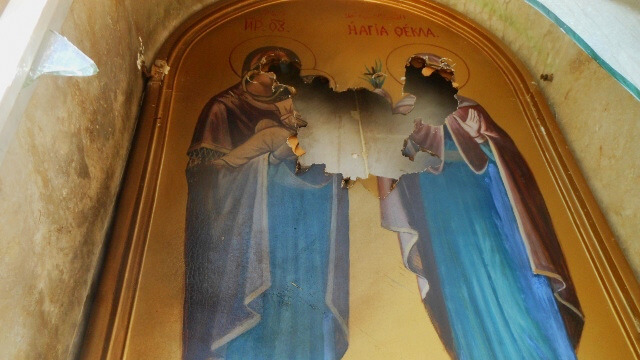
Destruction in the Convent’s Church of St. John the Baptist in Maaloula. Eva Bartlett | In Gaza
As I wrote then:
There was the expected destruction from battles waged by and on the terrorists. There was further—clearly-intentional—destruction meted out systematically by the al-Qaeda death squads—particularly on Christian, cultural, and heritage sites. …
In Maaloula, terrorists likewise took great apparent pleasure in destroying and desecrating Christian relics, to the extent of gouging out the eyes from icons and mosaics and shooting down the large clifftop Jesus and Mary statues which had overlooked the village. They likewise burned, robbed and vandalized churches and homes. …
Outside of the early fourth century A.D. Monastery of Sts. Sergius et Bacchus, NDF volunteers and other locals swept rubble, and prepared for the long process of restoration. Inside the ancient church, light poured through mortar holes in the unadorned white dome smashed by terrorist-fired mortars. According to the General, when the SAA had pushed the invaders back beyond the monastery, the terrorists fired mortars towards the monastery and village. They later occupied the monastery, then looted and vandalized it. …
‘They stole many idols from here, including the oldest one in the church,’ the volunteer said. The smashed altar with its unique ridged rim is said to be from between 330 and 325 A.D. ‘In other churches, the altar is rectangular and flat. And only here the altar is a half-circle and rimmed, like the altars of pagans for their animal sacrifice,’ she explained. …
The arson at the tenth-century Convent of St. Thekla was visible from the street, the top two floors utterly blackened by fires set by the invaders. …
In the convent’s Church of St. John the Baptist they likewise set fires, black soot reaching the painted dome high above. They completely destroyed the altar, as well as the pews—which presumably fueled the fire. Throughout the halls of the convent and inside the church itself, NATO’s mercenaries tore, stabbed, burned, or stole Christian iconography, looting what they could, meticulously destroying what was unmovable. Since none of that was possible for the images painted directly on stone walls, they instead machine-gunned the eyes and faces of Mary and Jesus, as well as a stone cross.”
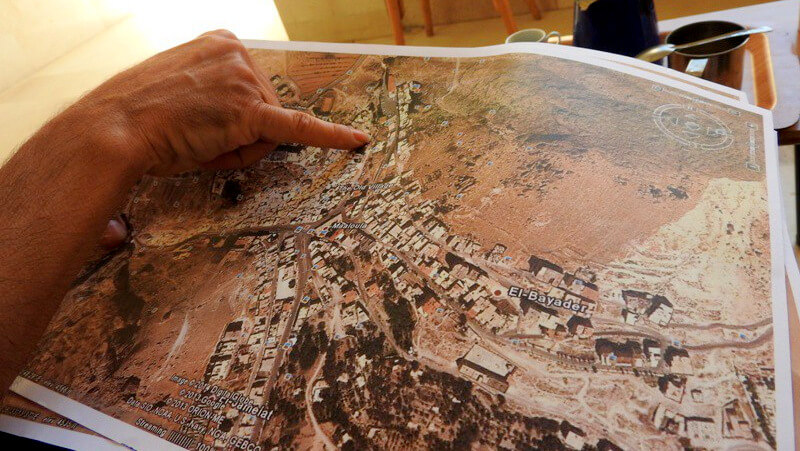
A Maaloula local defence soldier traces the battles on a map of the town in 2013. Eva Bartlett | In Gaza
When I revisited in the summer of 2016, much had changed. The area was cleaned and stores had reopened. In September of 2013, I wrote about the point-blank assassinations of unarmed Maaloula citizens and of the defenders of Maaloula — locals who left their trades to take up arms in defense of their historic town and people. Not long after, invading terrorists, under the guise of anti-government rebels, assassinated an elderly man who had refused to leave his town.
On a street below, near the main square, a man and some children collected water from a spring. It was at that spring on September 17, 2013, that 65-year-old farmer Zaki Tabib was shot in his head by a terrorist sniper. Tabib was one of about fifteen mostly-elderly villagers who had refused to evacuate a week earlier.
Abdo Haddad, also one of Tabib’s nephews, commented on the stoicness of his uncle and men like him: ‘These old men are so pure in their heart that they don’t believe someone in their village would kill them.’”
Left bleeding on the street, Tabib was dead by the time his two courageous nephews braved a torrent of sniper fire to retrieve his body, in order to give him a proper burial.
On that 2016 visit, I also wrote about the destruction that still plagued the town:
Piles of rubble lay at many corners, and gaping holes in some walls remained evidence of the near total damage to the old part of the village. Although official estimates were that 80 percent of the homes were damaged, Abdo Haddad pointed out that “damage” in most cases means missing entire walls, and that in fact every house in the old quarter suffered damage, from mild to entire.
Many homes were boobytrapped by terrorists, to further kill and destroy. ‘They rigged houses so that when someone opened the door, an electrical trigger with a small charge would detonate and explode a gas canister,’ Haddad explained, saying that they could not count the number of rigged houses, maybe tens, maybe more: ‘The whole village was on fire. For the safety of the soldiers, in many cases the army had to blow the booby trap instead of defusing it.”
The church walls and dome roof of St. Thekla convent remained blackened with soot from the fires terrorists lit within. Local stonemasons stood on scaffolding, patiently rebuilding the thick walls in the traditional manner. Up the long staircase above the convent, the tomb in the cliffside grotto remained sooty black but was tidied up, with a few of the icons returned until complete restoration is possible. Other icons will never be returned — destroyed or stolen by the terrorist bandits, which occupied the convent.”
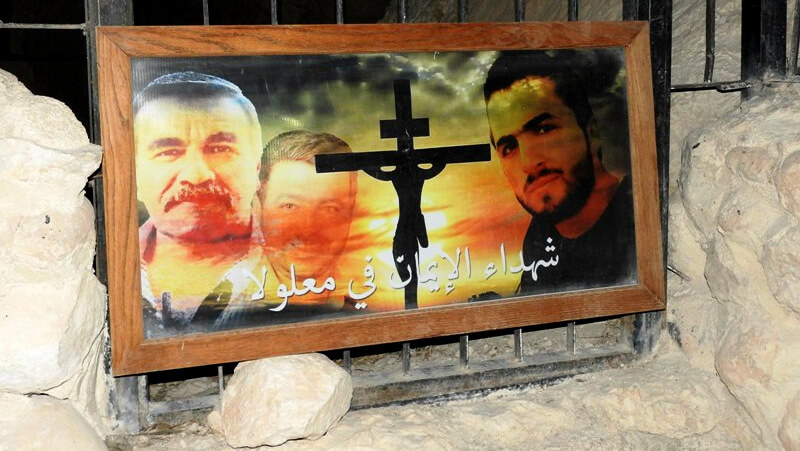
Mikhael Taalab, Anton Taalab, and Serkis Zakhen, assassinated by terrorists on September 7, 2013. Eva Bartlett | In Gaza
Upon my return to Maaloula on September 13, 2018, I stood on Abdo Haddad’s balcony looking out upon one of the town’s historic mountains. It was from these mountaintops that terrorists rolled explosive-stuffed tires onto the simple homes below. It was from these mountaintops that terrorist snipers killed Zaki Tabib.
On September 13, those mountaintops were adorned with the traditional brightly-lit crosses of the Festival of the Cross.
I attended mass in Maaloula’s Catholic church. The rituals of countless years continue, as do the devotion of Maaloula’s residents, with both clergy and congregation singing the mournful lyrics sung for centuries. This is the culture that Western-backed fanatics attempted to destroy.
Watch | Mass during Maaloula’s Festival of the Cross
From devotion to celebration
Immediately following the mass, the congregation quickly exited into the church square. By the time I arrived at the door, the exit was nearly impassable as so many people had amassed in the square. Pushing through, I saw the cause of the crowd: raised on the shoulders of residents, two men sang songs traditional to the Festival of the Cross, swigging frequently from plastic bottles of Arak in their hands. The crowd periodically cheered at their words, and eventually moved — cheering, singing — to the main square.
By the time I made it to the main square, it was likewise completely full of celebrants, many swigging Arak, cheering, singing traditional songs, and praising their army and president. Mini-Syrian flags abounded, as did people on balconies to watch the festive chaos. This went on for over an hour before crowds started moving up the mountains. Later, down in the town square, they were dancing.
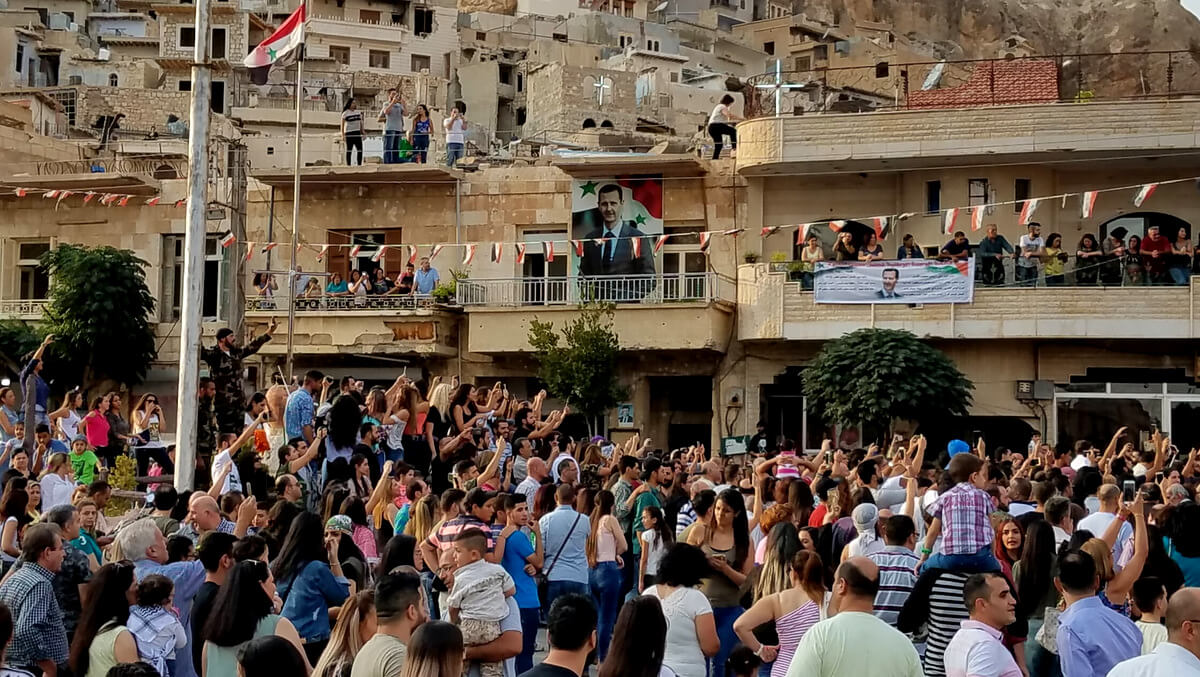
Crowds gather to in Maaloula Syria’s town square to celebrating the Festival of the Holy Cross. Eva Bartlett | In Gaza
When I later made this arduous hike up often-challenging mountainside, it was nearing sunset. Strong, young Maaloula men were stationed at more difficult points of the mountain trail, pulling people up when necessary.
One such young man joined me to help me navigate the path, sometimes leading me down steep inclines on shortcuts to the top.
Reaching the top in darkness, the glare of multiple crosses and the blazing bonfire was enough illumination to see masses of people, mostly young but also elderly and families, standing and sitting perilously close to the mountain edge, overlooking the glowing village below.
Periodically, a burst of whirling light burst out, as people in the town square far below spun fire. Throughout the night, crowds sat drumming, singing, and watching the bonfire.
Watch | Devotees attend Maaloula’s Festival of the Holy Cross
I asked Abdo Haddad to summarize the importance of the Festival of the Cross. He said (video):
Tonight we are celebrating the finding of the cross that happened 1700 years ago. This celebration is represented by putting fire on top of the mountains, from Jerusalem to Constantinople, to tell the people in Constantinople that the cross was found.
Maaloula is the only place in the world that is still celebrating this custom.
The only time that this custom stopped is when the so-called rebels and other “revolution” people in Syria invaded Maaloula, and instead of putting fire on top of the mountain, they put our houses on fire. But since we are sons and daughters of life, we kept on celebrating it since Maaloula was liberated by the Syrian army in 2014.
So we celebrate life now, and we celebrate the cross.
We were born here 3,000 years ago and we’ll keep existing until the end of time.”
In 2016, Syria’s First Lady, Mrs. Asma al-Assad, was interviewed by Russia 24. During that interview, she spoke of the struggles Syria has faced during its ancient existence. Particularly poignant, and fitting to end with, were these words:
Syria comprises of land that has been continuously inhabited for a very long time. Over thousands of years, this soil has been exposed to dozens of wars and invasions. Some areas were completely destroyed. I know that Syria can and will rebuild itself. … As Syrians, we’ve always prevailed and this period in our history is no different. It is known or often said that Syria means ‘rising sun.’ And Syrians will rise again, that I can assure you.”
Top Photo | A Maaloula fire spinner during the annual September Festival of the Holy Cross in Maaloula, Syria. Eva Bartlett | In Gaza
Eva Bartlett is a Canadian independent journalist and activist. She has spent years on the ground covering conflict zones in the Middle East, especially in Syria and Palestine. She is a recipient of the International Journalism Award for International Reporting. Visit her personal blog, In Gaza, and support her work on Patreon.
The post Damascus Trade Fair and Festival of the Cross Mark the Return of Peace to Much of Syria appeared first on MintPress News.
